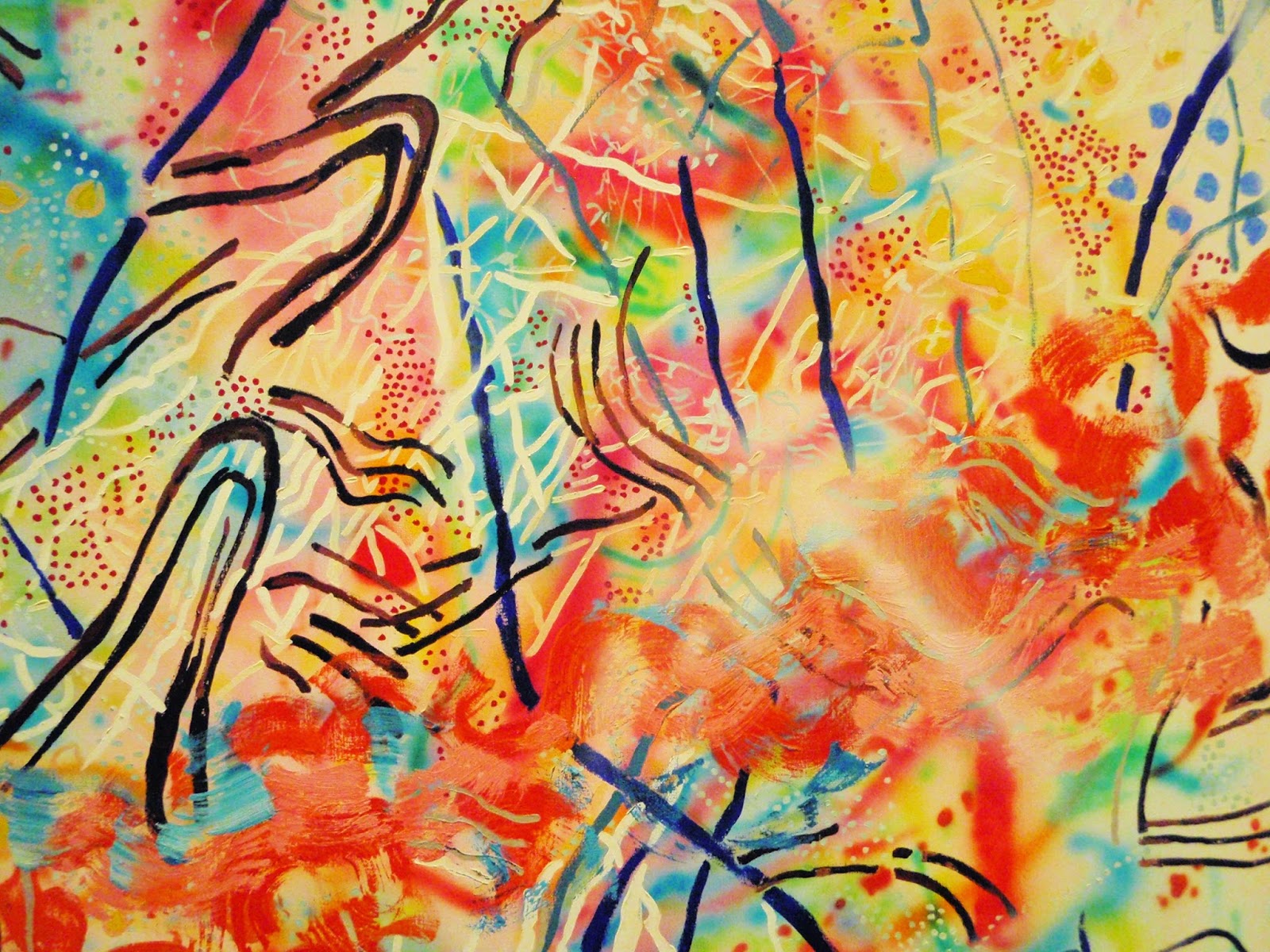I guess the National Gallery of Art is undergoing some renovations, because there have been two local exhibits featuring parts of their vast collection: an Impressionist show that closed this summer at the Legion of Honor, and then over at the de Young museum modernist works from the Robert & Jane Meyerhoff Collection. Contrary to the usual practice in special exhibitions, photography was allowed in both; I assume this is because they come from a government-run museum. All of the photos of paintings below are only details and sections of the works; if you want to see the whole thing, the National Gallery allows you to search their catalogue on-line. The show is at the de Young until 12 October.
The entry way. All of the other photos are of paintings.
This is from Ad Reinhardt's Untitled (Yellow and White) of 1950. It's very forthrightly yellow, though I think it's meant as sort of a zebra painting, as in: is it black with white stripes, or white with black stripes? There are two shades of yellow there, though perhaps that's more a matter of how thickly textured the paint is.
The four below are all from Hans Hofmann's Autumn Gold of 1957. You can see the whole thing here. The paint textures are really rich in this one; it's good to see it in person.
Here's a whole painting: Frank Stella's Flin Flon IV of 1969. The exhibit is nicely arranged, with lots of space around the paintings, many of which are quite large.
Across from the Stella is an enclosed room which holds Barnett Newman's Stations of the Cross: Lema Sabachthani, a suite of fifteen paintings that correspond to the fourteen traditional stations of the cross (I don't remember what the fifteenth painting in this series represents). Lema Sabachthani is a shortened version of one of the sayings of Jesus on the cross: Eli, Eli, lama sabachthani? which means, My God, my God, why hast thou forsaken me? The phrase is found in Matthew 27:46 and also in Mark 15:34 (which gives Eloi, Eloi instead of Eli, Eli). The omission of the reference to God may explain why this Jewish artist chose a traditionally Catholic subject: the paintings are meditations on spiritual struggle in an abandoned world. They benefit from being seen together and in isolation, creating an atmosphere similar to that of the Rothko Chapel in Houston.
Below is a detail of the first station:
The one below gives you some sense (I hope) of the atmosphere the paintings create. Each canvas is well over six feet tall and about five feet wide.
Below is a detail from British artist Howard Hodgkin's Souvenirs of 1980-1984:
Below is a close-up section of Agnes Martin's Untitled #2 of 1981. I really loved this one so I had to include it here but none of the photos I took do justice to the subtlety of the colors or the textures. There are horizontal stripes of very pale red, kind of a beige-white, and very pale blue. I find her work very meditative; it rewards close contemplation. (That's another Martin painting I'm looking at in my avatar above.)
Eric Fischl's Saigon Minnesota of 1985 is a very large, unsettling work. It seems at first like some sort of family gathering in a suburb. But it's on four panels of different sizes, which look oddly cobbled together, so that there is no smooth surface. It's obviously summer, given the bathing suits and popsicles, but the very bright colors have an acrid edge.
Then you notice details like the man at the top and center of the work, who is missing an arm. Is Saigon a reference to the Vietnam War? Is the man a wounded veteran, who has brought the war home to Minnesota? In a note posted near the painting, Fischl says that the title came to him as he was working on the painting and noticed that some of the people were "[taking] on an Asian appearance while he painted. At the same time, the national press was reporting on an alleged child-abuse scandal in a small Minnesota town."
You wouldn't necessarily think "child-abuse scandal!" when you saw the painting, but there is something at least potentially disquieting going on in many of the poses. Even the characters who look like young people enjoying their summer take on an oddity in these surroundings.
The longer you look, the more fraught and ambiguous seem the relations among these people.
Across from the Fischl is Agualine of 1980 by Nancy Graves. I really loved this strong, vibrant, joyous work. Click here to see the whole thing and read some more information about the painting.
Philip Guston's Courtroom was in his controversial exhibit of 1970, when he puzzled and alarmed his public by returning to figurative painting.






















1 comment:
Bravo.
Post a Comment